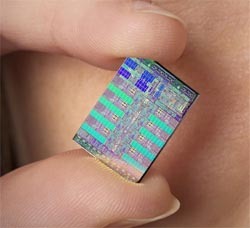Cell processor to run at more than 4 GHz
San Francisco (CA) - UPDATE - IBM, Sony and Toshiba unveiled more details about their much anticipated Cell processor that is said to crush the performance of current AMD and Intel processors. The chip likely will debut in the Playstation 3 and top clock speeds of 4 GHz.
It wasn't quite the detail many attendees of ISSCC had hoped for, but IBM, Sony and Toshiba revealed enough information about their much-hyped Cell processor to spur discussion and speculation of the impact of the chip when it hits the market. The prototype shown at the conference is based on Power architecture, integrates nine cores and runs at "more than 4 GHz".
The basic structure of the chip is comprised out of one 64-bit PowerPC chip and eight "synergistic processing units" (SPEs), the firms said. The PowerPC processor will integrate 32 kByte L1 and 512 kByte L2 cache, while the SPEs will use 256 kByte cache.
The "operating system neutral" chip is manufactured in 90 nm SOI, has a 221 mm2 footprint and integrates 234 million transistors. This compares to about 125 million transistors of the current Pentium 4 processor, which measures 122 mm2.
The additional data provided still doesn't answer the question how capable the Cell chip will be in the end and which processor could be threatened, if the developer trio can deliver on its promise to build a "supercomputer on a chip". According to a statement, Cell will be about ten times faster than the "latest PC processors".
Analysts such as Dean McCarron from Mercury Research stressed that revolutionary chips such has the Cell processor had been announced in the past, but were not successful to post a major and lasting threat for the x86 architecture. According to IBM and Sony, Cell is targeted to become a "broadband processor" for industrial applications and the "digital home". Applications will include Sony's Playstation 3, high-end consumer electronics such as digital televisions and home entertainment systems and supercomputer-like workstations that promise multimedia developers significant more processing performance.
Industry watchers also expect the Cell chip to become available in a version for rack servers where the potentially could target next-generation Intel Itanium systems.
Get Tom's Hardware's best news and in-depth reviews, straight to your inbox.

Wolfgang Gruener is an experienced professional in digital strategy and content, specializing in web strategy, content architecture, user experience, and applying AI in content operations within the insurtech industry. His previous roles include Director, Digital Strategy and Content Experience at American Eagle, Managing Editor at TG Daily, and contributing to publications like Tom's Guide and Tom's Hardware.
